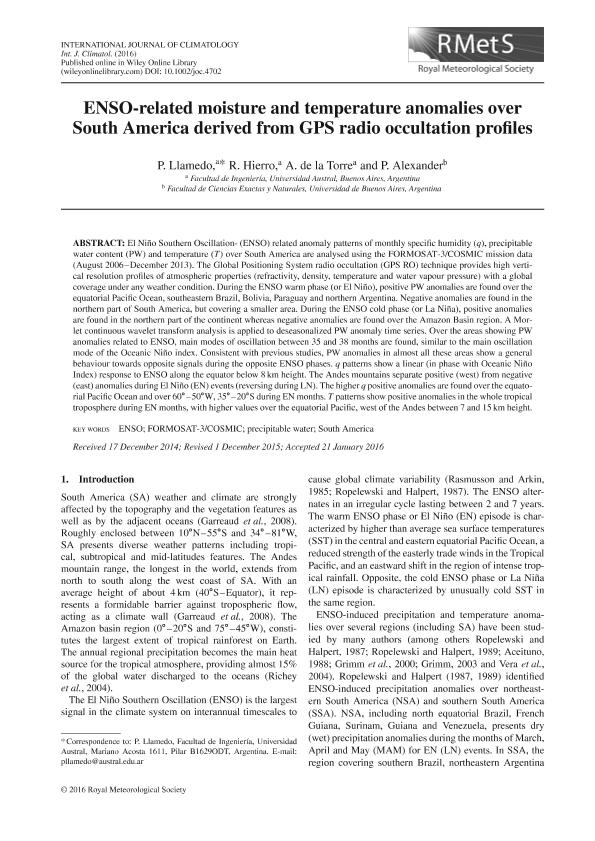Mostrar el registro sencillo del ítem
dc.contributor.author
Llamedo Soria, Pablo Martin

dc.contributor.author
Hierro, Rodrigo Federico

dc.contributor.author
de la Torre, Alejandro

dc.contributor.author
Alexander, Pedro Manfredo

dc.date.available
2019-03-29T18:11:29Z
dc.date.issued
2017-01
dc.identifier.citation
Llamedo Soria, Pablo Martin; Hierro, Rodrigo Federico; de la Torre, Alejandro; Alexander, Pedro Manfredo; ENSO-related moisture and temperature anomalies over South America derived from GPS radio occultation profiles; John Wiley & Sons Ltd; International Journal of Climatology; 37; 1; 1-2017; 268-275
dc.identifier.issn
0899-8418
dc.identifier.uri
http://hdl.handle.net/11336/72854
dc.description.abstract
El Niño Southern Oscillation- (ENSO) related anomaly patterns of monthly specific humidity (q), precipitable water content (PW) and temperature (T) over South America are analysed using the FORMOSAT-3/COSMIC mission data (August 2006–December 2013). The Global Positioning System radio occultation (GPS RO) technique provides high vertical resolution profiles of atmospheric properties (refractivity, density, temperature and water vapour pressure) with a global coverage under any weather condition. During the ENSO warm phase (or El Niño), positive PW anomalies are found over the equatorial Pacific Ocean, southeastern Brazil, Bolivia, Paraguay and northern Argentina. Negative anomalies are found in the northern part of South America, but covering a smaller area. During the ENSO cold phase (or La Niña), positive anomalies are found in the northern part of the continent whereas negative anomalies are found over the Amazon Basin region. A Morlet continuous wavelet transform analysis is applied to deseasonalized PW anomaly time series. Over the areas showing PW anomalies related to ENSO, main modes of oscillation between 35 and 38 months are found, similar to the main oscillation mode of the Oceanic Niño index. Consistent with previous studies, PW anomalies in almost all these areas show a general behaviour towards opposite signals during the opposite ENSO phases. q patterns show a linear (in phase with Oceanic Niño Index) response to ENSO along the equator below 8 km height. The Andes mountains separate positive (west) from negative (east) anomalies during El Niño (EN) events (reversing during LN). The higher q positive anomalies are found over the equatorial Pacific Ocean and over 60°–50°W, 35°–20°S during EN months. T patterns show positive anomalies in the whole tropical troposphere during EN months, with higher values over the equatorial Pacific, west of the Andes between 7 and 15 km height.
dc.format
application/pdf
dc.language.iso
eng
dc.publisher
John Wiley & Sons Ltd

dc.rights
info:eu-repo/semantics/openAccess
dc.rights.uri
https://creativecommons.org/licenses/by-nc-sa/2.5/ar/
dc.subject
Enso
dc.subject
Formosat-3/Cosmic
dc.subject
Precipitable Water
dc.subject
South America
dc.subject.classification
Meteorología y Ciencias Atmosféricas

dc.subject.classification
Ciencias de la Tierra y relacionadas con el Medio Ambiente

dc.subject.classification
CIENCIAS NATURALES Y EXACTAS

dc.title
ENSO-related moisture and temperature anomalies over South America derived from GPS radio occultation profiles
dc.type
info:eu-repo/semantics/article
dc.type
info:ar-repo/semantics/artículo
dc.type
info:eu-repo/semantics/publishedVersion
dc.date.updated
2019-03-29T12:12:46Z
dc.journal.volume
37
dc.journal.number
1
dc.journal.pagination
268-275
dc.journal.pais
Reino Unido

dc.journal.ciudad
Londres
dc.description.fil
Fil: Llamedo Soria, Pablo Martin. Universidad Austral. Facultad de Ingeniería. Departamento de Ciencias Básicas; Argentina. Consejo Nacional de Investigaciones Científicas y Técnicas; Argentina
dc.description.fil
Fil: Hierro, Rodrigo Federico. Universidad Austral. Facultad de Ingeniería. Departamento de Ciencias Básicas; Argentina. Consejo Nacional de Investigaciones Científicas y Técnicas; Argentina
dc.description.fil
Fil: de la Torre, Alejandro. Universidad Austral. Facultad de Ingeniería. Departamento de Ciencias Básicas; Argentina. Consejo Nacional de Investigaciones Científicas y Técnicas; Argentina
dc.description.fil
Fil: Alexander, Pedro Manfredo. Consejo Nacional de Investigaciones Científicas y Técnicas. Oficina de Coordinación Administrativa Ciudad Universitaria. Instituto de Física de Buenos Aires. Universidad de Buenos Aires. Facultad de Ciencias Exactas y Naturales. Instituto de Física de Buenos Aires; Argentina
dc.journal.title
International Journal of Climatology

dc.relation.alternativeid
info:eu-repo/semantics/altIdentifier/doi/http://dx.doi.org/10.1002/joc.4702
dc.relation.alternativeid
info:eu-repo/semantics/altIdentifier/url/https://rmets.onlinelibrary.wiley.com/doi/abs/10.1002/joc.4702
Archivos asociados
